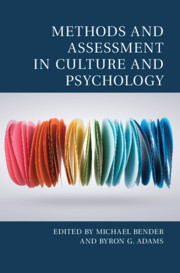Book contents
- Methods and Assessment in Culture and Psychology
- Culture and Psychology
- Methods and Assessment in Culture and Psychology
- Copyright page
- Dedication
- Additional material
- Contents
- Figures
- Tables
- Contributors
- Foreword
- 1 Introduction to Methods and Assessment in Culture and Psychology
- Part 1 Acculturation and Identity
- Part 2 Individual Differences across Cultures
- 6 Broadening the Bases of Methodological Rigor in Cross-Cultural Educational Assessment
- 7 Individuals, Groups, and Classrooms: Conceptual and Methodological Considerations on Studying Approaches to Cultural Diversity in Schools
- 8 Emotion between Universalism and Relativism: Finding a Standard for Comparison in Cross-Cultural Emotion Research
- 9 Culture Is More Than Self-Reported Motives, Beliefs, and Values: Methodological Advancements of Measuring Implicit Motives across Cultural Contexts
- 10 Development of the South African Personality Inventory: A Cross-Cultural Design in a Non-Western Society ‒ Lessons Learned and Generalizability to Other Parts of the World
- 11 Combining Global and Local Approaches in Psycholexical Studies: Glocal Illustrations from Studies on Arabic
- Part 3 Culture and Assessment
- Index
- References
6 - Broadening the Bases of Methodological Rigor in Cross-Cultural Educational Assessment
from Part 2 - Individual Differences across Cultures
Published online by Cambridge University Press: 21 January 2021
- Methods and Assessment in Culture and Psychology
- Culture and Psychology
- Methods and Assessment in Culture and Psychology
- Copyright page
- Dedication
- Additional material
- Contents
- Figures
- Tables
- Contributors
- Foreword
- 1 Introduction to Methods and Assessment in Culture and Psychology
- Part 1 Acculturation and Identity
- Part 2 Individual Differences across Cultures
- 6 Broadening the Bases of Methodological Rigor in Cross-Cultural Educational Assessment
- 7 Individuals, Groups, and Classrooms: Conceptual and Methodological Considerations on Studying Approaches to Cultural Diversity in Schools
- 8 Emotion between Universalism and Relativism: Finding a Standard for Comparison in Cross-Cultural Emotion Research
- 9 Culture Is More Than Self-Reported Motives, Beliefs, and Values: Methodological Advancements of Measuring Implicit Motives across Cultural Contexts
- 10 Development of the South African Personality Inventory: A Cross-Cultural Design in a Non-Western Society ‒ Lessons Learned and Generalizability to Other Parts of the World
- 11 Combining Global and Local Approaches in Psycholexical Studies: Glocal Illustrations from Studies on Arabic
- Part 3 Culture and Assessment
- Index
- References
Summary
In educational assessment, both cognitive and contextual variables are important to help us understand how students can be successful in school and society. In cross-cultural comparisons, we strive to capture cultural similarities and differences in target constructs while minimizing cultural bias to reach valid conclusions. We provide an overview of this endeavor with an integration of three perspectives. We first introduce the use of quantitative methodological rigor to address bias in national and international educational assessment. We then describe qualitative and mixed-methods research to deepen our understanding of the root cause of bias. Lastly, we discuss the effect of language in learning and assessments of minority students’ achievement. We conclude that educational assessment research would benefit from a further integration of multiple approaches, and taking full account of variations in contextual factors such as language proficiency.
- Type
- Chapter
- Information
- Methods and Assessment in Culture and Psychology , pp. 103 - 122Publisher: Cambridge University PressPrint publication year: 2021
References
- 1
- Cited by



